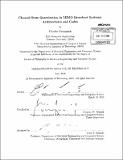Channel state quantization in MIMO broadcast systems : architectures and codes
Author(s)
Swannack, Charles (Charles Henry)
DownloadFull printable version (36.18Mb)
Alternative title
Channel state quantization in multi-input multi-output broadcast systems : architectures and codes
Other Contributors
Massachusetts Institute of Technology. Dept. of Electrical Engineering and Computer Science.
Advisor
Gregory W. Wornell.
Terms of use
Metadata
Show full item recordAbstract
It is now well understood that the use of a multiple-element antenna array at the transmitter can, in principle, greatly increase the capacity of wireless systems. However, little is known about the performance characteristics of such wireless systems in a network setting, or about how to optimize the design of such systems, especially when complexity is taken into account as a practical constraint. This thesis studies the problem of multi-user multiple-antenna broadcast system design with an emphasis on the role that channel feedback plays in a network setting. We develop new design principles for channel feedback design in such systems and show that the system designer is afforded extra degrees of freedom in the choice of the channel quantizer due to the multi-user diversity of the system. As such, the system designer may use the extra degrees of freedom to design structured quantizers that aid in user selection and allow the system to adapt to heterogeneous user populations with different fading characteristics. We construct an adaptive quantization framework which, when paired with low-complexity graph algorithms, enables efficient and robust user scheduling for multi-user multiple-antenna broadcast systems.
Description
Thesis (Ph. D.)--Massachusetts Institute of Technology, Dept. of Electrical Engineering and Computer Science, 2010. Cataloged from PDF version of thesis. Includes bibliographical references (p. 273-282).
Date issued
2010Department
Massachusetts Institute of Technology. Department of Electrical Engineering and Computer SciencePublisher
Massachusetts Institute of Technology
Keywords
Electrical Engineering and Computer Science.